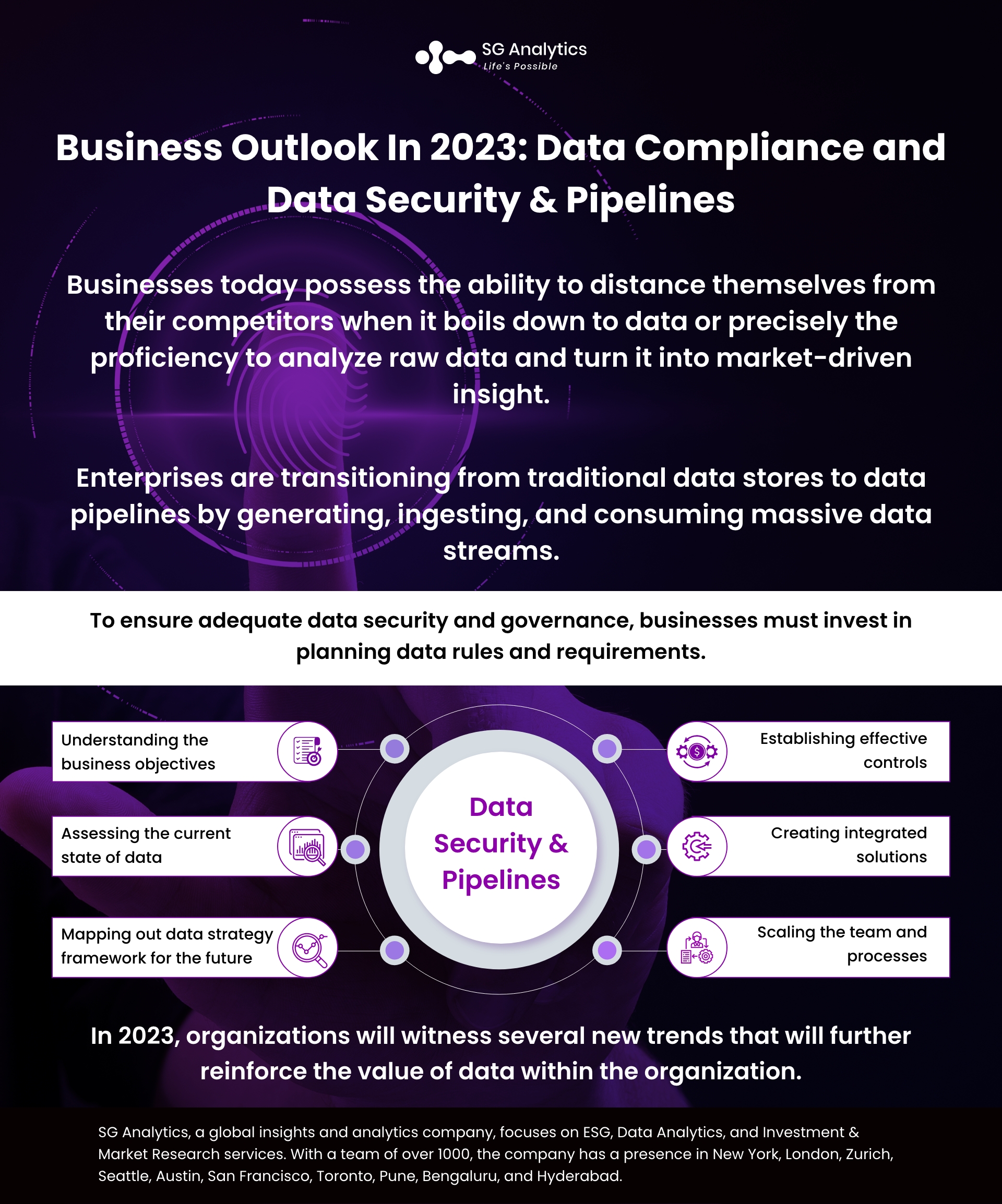In the ultra-competitive business environment, businesses must possess the ability to distance themselves from their competitors when it boils down to data or precisely the proficiency to analyze raw data and turn it into market-driven insight. Data was and is still the most asset for an organization. And with the value of data rising to unprecedented levels, industry leaders are making efforts to protect the data more aggressively.
In 2023, organizations will witness several new trends that will further reinforce the value of data within the organization.
Data security is becoming the New Executive-level Concern
Data is no longer a stagnant entity. It is being analyzed and shared continuously across networks. The potential for data to yield business insights is at an all-time high. Due to this convergence of data usage and data protection, businesses will likely prioritize data protection and security in 2023. A recent study discovered that 62% of business leaders expect their security budget to rise by as much as 10% in 2023.
Read more: Top Data Science Trends to Look Forward in 2023

The concern over the potential business benefits of preserving data privacy is emerging as a tremendous motivator to dedicate resources and always protect them.
Enterprises are more aggressively transitioning from traditional data stores to data pipelines. They are generating, ingesting, as well as consuming massive streams of data. This data is critical for business success due to the increasing investments in data processing infrastructure along with data engineering personnel within the organization.
Businesses are experiencing an accelerated reliance on data pipelines, offering them multiple sources to feed a data warehouse by employing data streaming mechanisms. This will help in replacing the traditional approaches. Innovative approaches will allow sensitive data to be de-identified in such data streams, enabling them to gain more prominence.
A singular truth exists within the world of data security. The truth is - not all data is created equal. But companies have the habit of treating all the accumulated data in the same way. The increase in cross-platform usage indicates that data is more spread out in the enterprise. This indicates that the most sensitive data is being protected at the same level as the least sensitive one. To ensure adequate data security and governance, businesses need to invest in planning data rules and requirements.
-
Understanding the business objectives
-
Assessing the current state of data
-
Mapping out data strategy framework for the future
-
Establishing effective controls
-
Creating integrated solutions
-
Scaling the team and processes

Read more: Data & Analytics Strategy: Must-Have Crucial Elements for Decision Making
Compliance - A Top Priority for Businesses
With governments issuing new data privacy laws, many industry regulators are diverting their attention to integrating these data privacy laws within their operations for varying rigidity and nuances that make compliance complex. As more data privacy laws are taking effect worldwide, organizations that have not taken any appropriate steps to protect their data are incurring significant fines.
Forward-thinking organizations are exploring beyond compliance to protect their organizational data by integrating methods that help in lowering the risk of the eventual breach with a data-centric approach. This approach can be considered a fail-safe posture, but the lost data is unusable, which further eliminates the prospect of embarrassing disclosure and damages.
Companies are now devising plans to ease the burden of potential noncompliance to reap more rewards from their data. Addressing compliance enables them to take a proactive posture and avoid costly fines, along with reputational damage. It is helping them to gain a competitive edge over the industry competitors, who take a rather reactive approach.

Data leaders should now be crystal clear about the priorities of their organization as well as how to employ the collected data and AI to deliver and accelerate business goals. By identifying the bigger picture of where and what's ahead, businesses can design a strategic context to devise actionable plans for delivery. By identifying the outcomes, objectives, and measures, business leaders can keep track of the data's progress and share it with the enterprise as the journey unfolds. Some of the elements to include in the data strategy are as follows:
-
Observations, data challenges, and recommendations
-
Objectives and outcomes
-
Cross-functional data for supporting multiple use cases
-
Data privacy and security requirements
-
Data organizations and pipelines
-
Action plan for the selected data area
Read more: Data Fabric and Architecture: Decoding the Cloud Data Management Essentials
Securing Data in a Business-oriented Manner

With data storage evolving, data security is looking into how data is advancing throughout the enterprise to control loss and leakage. Today, 11% of business units have zero involvement in setting information security policies. Today's goal is to create a data ecosystem without leaking sensitive information. The aim is to secure the point of creation instead of opting for a traditional approach to secure the information that is being sent.
Essentially, organizations need to focus less on creating secure pipelines for data and stress more on employing smart information that knows where it is supposed to be. This will enable the right person within the organization to access the right data and initiate desired business outcomes.
By 2024, organizations will use active metadata effectively to reduce the time to integrated data delivery by half and improve the productivity of data teams by 20%.
How Organizations Should Address this Trend
Organizations are now seeking to shrink data risk and adopt an assumed breach posture to make the data security risk irrelevant. Businesses that understand this will utilize proactive protection methods at record levels that will assist in rendering data unusable to hackers. This shift is good for businesses, as they can enhance their corporate reputation and build customer trust.

Given the evolving and future-looking technologies, in 2023, businesses will witness data leaders making selective decisions to pick out and integrate trends that best align with their organizational needs. This will facilitate the development of short- and long-term roadmaps to align data and operational framework with the developing trends, thereby enabling the organizations to evolve gradually.
From a pure business perspective, it makes sense for businesses to curtail unstructured ad-hoc decisions that are siloed and properly harmonize with the collective decision outcomes within the organization. With new data security tools emerging, businesses can implement data compliance and security strategies practically.
Read more: 7 Trends That BFSI Industry Cannot Ignore Anymore- Get Ready for 2023
Final Thoughts
Today data is more pervasive than ever. However, taking advantage of this full potential mandates creativity and conviction. Data leaders now need to navigate this ever-evolving pool of internal and external data sources and design strategy and direction in an increasingly competitive marketplace.

Leaders are now striving for real-time decisions and predictive models that assist them in keeping the organization relevant. However, to get there, the data strategy must be designed with the right approach to make sense of vast amounts of data. The strategy should also align with the business values and produce solutions that span the entire organization.
Creative and innovative decision-making are emerging as the new stakes for success. For businesses to fully realize data's potential mandates vision, persuasion, and support. A framework infused with insights from industry data leaders will assist them in designing and implementing their data strategy while making the most of their teams, talents, and strengths.
Data security and privacy are no longer niche IT concerns. They are emerging as a critical business priority. With the value of data rising and more data privacy laws being enacted, organizations that stay within the curve may play catch-up in the coming years. The top priority for any organization's to-do list should be aggressively addressing data protection and security gaps in 2023.
With a presence in New York, San Francisco, Austin, Seattle, Toronto, London, Zurich, Pune, Bengaluru, and Hyderabad, SG Analytics, a pioneer in Research and Analytics, offers tailor-made services to enterprises worldwide.
A leader in Data Analytics, SG Analytics focuses on leveraging data management & analytics and data science to help businesses discover new insights and build strategies for business growth. Contact us today if you are looking to make critical data-driven decisions to prompt accelerated growth and breakthrough performance.









